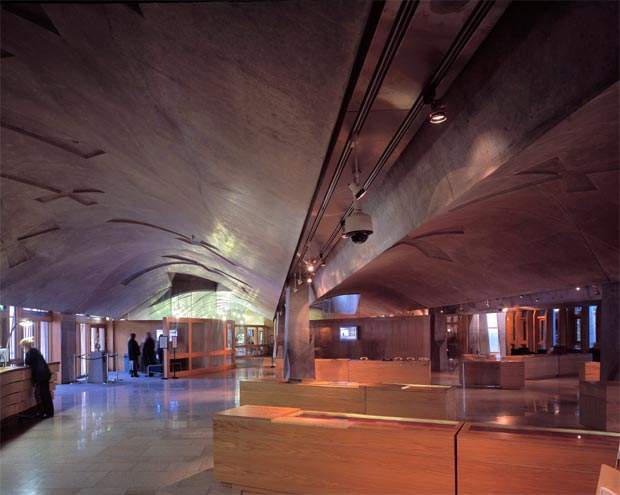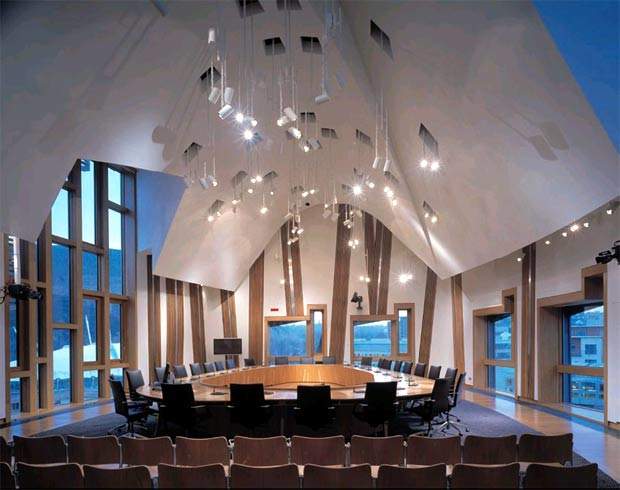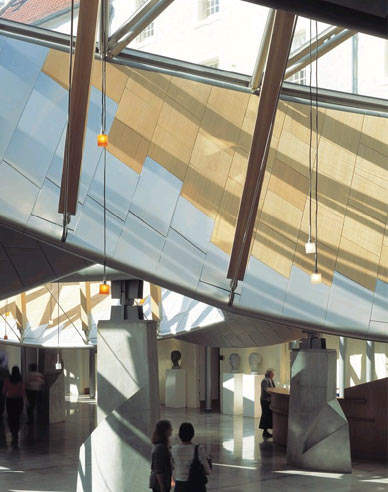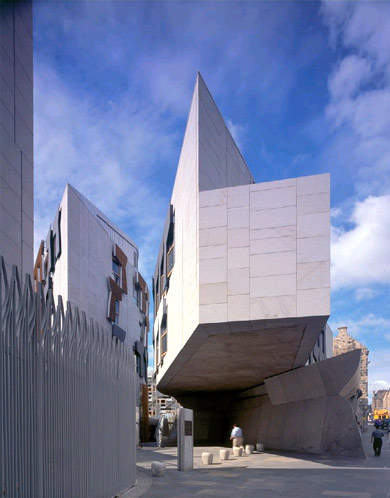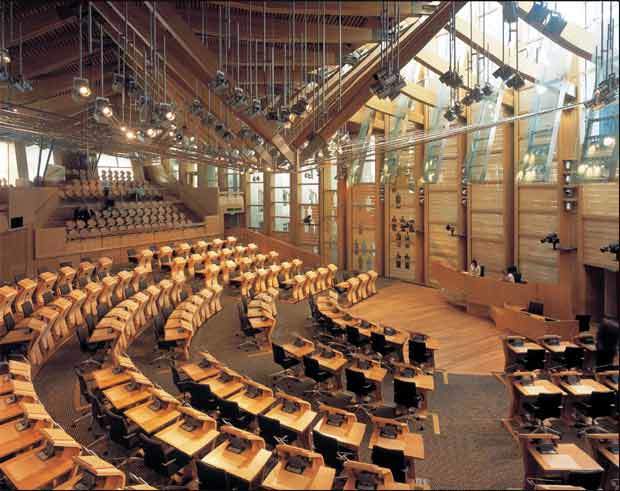The Scottish Parliament in Edinburgh is starting to enjoy some acclaim. It won the Royal Institute of British Architects’ Stirling Prize for 2005 and a place in at least some Scottish hearts.
The construction process involved a series of controversies over funding, as different parties treated the project as a political football. The criticism was not unexpected; the building came in ten times over the original £50m budget, with
widespread outrage at the spiralling cost of bespoke fittings, such as the £88,000 reception desk.
However, there can be no doubt that the combined venture between the Spanish firm EMBT, led by the dynamic Enric Miralles, and Scottish firm RMJM has created a building that is quite special.
The story goes that Enric Miralles, who led the Barcelona team and was the conceptual architect of the project, entered the first design meeting armed with a handful of leaves and twigs. Throwing them down on the table in a scattered heap, he
proclaimed: ‘That’s the Scottish Parliament’. Whether fact or fiction, the organic theme that underlies the project suggests the spirit of the story was accurate, if nothing else.
THE LOBBY
The Parliament Building is made up of a group of buildings surrounding a central enclosed lobby, similar to a university quad or monastery cloister. The structures follow Miralles’ design concept, with four towers shaped like the bows of lightly
docked boats forming a canopy over the lobby, like floating leaves on a quiet lake.
Inside the lobby, the ceiling is formed by a set of hulls cutting through the water flowing overhead, while from above the leaf motifs float gently above the bustling throng.
The lobby seems a hive of activity, with a constant stream of ministers making their way from the debating chamber on the east side to the MSP offices on the west side.
As with much of the Parliament, the light comes from many different pockets of glass reflecting across the walls and ceiling, with the angled beams adding to the feeling of being underwater.
THE FOUR TOWERS
The lake theme continues with the four towers. Consisting mainly of committee rooms, the towers are adjacent to the debating chamber and fan out around the edge of the lobby. Inside, the nautical detailing is everywhere, with the conical shapes of the
rooms complemented by the rigging-style decor.
Shaped elliptically, these unique rooms all have the ability to surprise with their subtle details. They are bright, but the light sources are well hidden, the windows tucked behind jutting ceiling squares and the light reflecting off other surfaces.
Every room has a view of the Salisbury Crags, in whose shadow the Parliament sits.
THE MSP BUILDING
The MSP Building is arguably the part of the Parliament that has attracted the most attention. The iconic west elevation is dotted with medieval window seats, or ‘thinking modules’, which have become synonymous with the building. Each Member of the
Scottish Parliament, or MSP, has one, and it is where much of the Parliament’s work is done.
QUEENSBURY HOUSE
Queensbury House, the only part of the Parliament that retains its original architecture, looks slightly out of place. Supposedly, in one of the few disputes between the two bodies, Historic Scotland refused to grant RMJM permission to roof the
building in a matching grey slate.
The result is slightly jarring; the grey slate would have allowed a more seamless blend of the two styles, rather than drawing attention to where one ends and the other begins.
THE DEBATING CHAMBER
The debating chamber was a particularly important area for Miralles. As the focal point of the Parliament, he wanted it to be a symbol of cooperation and inspire integrated government. The elliptical shape, with its blurred political divisions, was in
direct contrast to the more confrontational parliamentary model favoured by the Houses of Parliament in London.
The open space is filled with light from a variety of sources. Glass fins run down from the ceiling, and the ceiling is a mesh of jutting beams and stainless steel fixes. The bespoke furniture retains this light, airy feel. Meanwhile, the long public
gallery gives an interactive feel to the proceedings below.
THE PUBLIC FOYER
Underneath the enormous debating chamber sits the public entrance and foyer. A low-ceilinged room with concrete tubes to lead visitors inside, it certainly makes for an impressive entrance. However, it is poorly lit and a complete contrast to the
shimmering brightness of the rest of the building.
The walls and display areas in the foyer are covered with symbols of Scottish history. This kind of detail is noticeable in all the buildings, with the Saltire Cross carved into the concrete ceilings as well as the huge doors separating each
section.
Each of the MSP pods has the course of a different Scottish river carved into the ceiling, and wherever possible the materials are of Scottish origin. Stone is used throughout the building, and oak and sycamore are used for all the furniture. The
carpets were designed by Miralles himself.
DARING TO BE DIFFERENT
The building may be right in the centre of Edinburgh, but it boasts panoramic views of the Salisbury Crags to the south, with Arthur’s Seat directly behind it. The open, grassy landscape is suggestive of Scotland’s countryside in general, recalling
Miralles’ insistence that the Parliament must be ‘not just Edinburgh’s building but Scotland’s building’.
The contours of each of the structures, from the chamber to the four towers, point, or rather flow, towards the hills, sloping off into long, grass-covered ‘tails’ that reach ground level at the foot of the Crags. They are accessible to the public,
and also form areas of public seating and even a small amphitheatre, which has already been used for entertainment during the Edinburgh Festival.
The Scottish Parliament Building seems to sit better with the landscape than the surrounding architecture. However, the clever shapes and contours of the other structures allow them to coexist with the high street fairly comfortably. The Scottish
Parliament is testament to the importance of detail, and a compelling example of how to create a stirring symbol of national pride.

